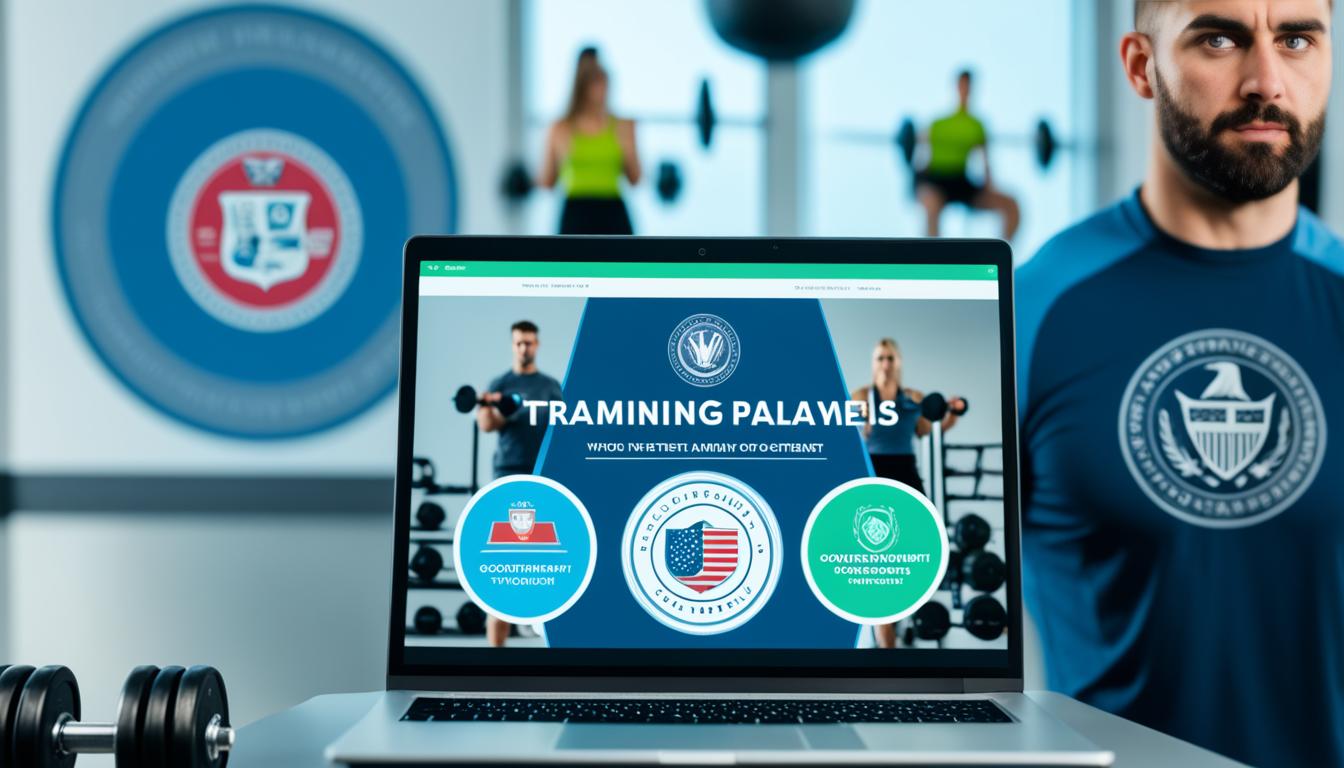Did you know that there are government–funded personal training courses online? That’s right, you can now pursue your dream of becoming a personal trainer without having to bear the burden of hefty course fees. These courses are not only accessible but also provide a pathway to acquiring Level 3 qualifications, equipping you with the skills needed to excel in the fitness industry.
Whether you are passionate about fitness or looking for a career change, government-funded personal training courses online offer a fantastic opportunity to turn your aspirations into reality. These courses are designed to cater to individuals who want to become personal trainers and obtain Level 3 qualifications without having to pay the full cost upfront.
Government funding can cover the entire cost of the course or provide partial funding, making it an affordable option for many aspiring personal trainers. With a range of funding options available, such as advanced learner loans and apprenticeships, you can choose the option that best suits your needs and circumstances.
By taking advantage of these government-funded courses, you can embark on a rewarding career in the fitness industry without worrying about the financial burden. So why wait? Start your journey to becoming a qualified personal trainer today!
Why Choose Government-Funded Personal Training Courses?

Government-funded personal training courses offer a fantastic opportunity for those who may not have the financial means to pay for their education upfront. These programs are designed to make education more accessible and to support the development of skilled professionals in the fitness industry. Here are some key benefits of choosing a government-funded personal training course:
- Financial Support: One of the main advantages is the financial assistance provided. This support can cover a significant portion, if not all, of your training costs, making it more affordable to pursue a career in personal training.
- Accredited Qualifications: Government-funded courses are typically accredited by reputable organizations, ensuring that you receive a high-quality education that is recognized within the industry.
- Flexible Learning: Many of these courses are available online, allowing you to study at your own pace and fit your learning around other commitments.
- Career Opportunities: Completing an accredited course can open doors to various career opportunities in the fitness industry, from working in gyms to starting your own personal training business.
Government Funded Personal Training Course Online Options
When it comes to pursuing a personal training career, there are numerous government-funded training options available. These options provide financial support to individuals who aspire to become personal trainers but may not have the means to pay for the entire course upfront. Let’s explore some of the government-funded personal training course options:
- Advanced Learner Loan: An advanced learner loan is a popular choice for individuals interested in government-funded personal training courses. With an advanced learner loan, the government provides funding that covers the cost of the course. The loan is repaid once the individual completes the course and starts earning over a specific income threshold. This option allows aspiring personal trainers to obtain the necessary qualifications without immediate financial burden.
- Apprenticeships: Apprenticeships offer a unique opportunity to combine on-the-job training with studying for a qualification as a personal trainer. This government-funded option allows individuals to gain practical experience while earning a qualification. Depending on the entry level, apprenticeships can lead to a Level 2 qualification as a fitness instructor or a Level 3 qualification as a personal trainer.
- Self-funded Personal Training Courses: Apart from government-funded options, individuals also have the choice to pursue self-funded personal training courses. These courses require individuals to pay the full course fee without government funding. While this may involve upfront costs, it provides flexibility in terms of choosing the course that best suits one’s needs.
- Non-funded Personal Training Courses: Similar to self-funded courses, non-funded personal training courses require individuals to bear the full cost of the course without government funding. This option allows individuals to explore a wide range of courses available in the market, tailoring their training to their specific requirements.
The government’s commitment to providing funding options for personal training courses allows individuals from diverse backgrounds to pursue their passion for fitness and embark on a fulfilling career as personal trainers.
Whether you choose an advanced learner loan, an apprenticeship, or opt for self-funded or non-funded courses, exploring government-funded personal training course options is an excellent way to gain the necessary qualifications without incurring substantial upfront costs.
For you to clearly understand,
Several types of government-funded personal training courses are available, each catering to different levels of experience and career aspirations. Let’s take a look at some of the popular options:
1. Level 2 Gym Instructor Course

The Level 2 Gym Instructor Course is the entry-level qualification for those looking to start a career in the fitness industry. This course covers the basics of gym instruction, including how to plan and deliver safe and effective exercise sessions. Topics typically covered include:
- Anatomy and physiology
- Principles of exercise and fitness
- Health and safety in a gym environment
- Planning and delivering gym-based exercise
2. Level 3 Personal Trainer Course
The Level 3 Personal Trainer Course is designed for those who want to take their career to the next level and become fully qualified personal trainers. This course builds on the knowledge gained in the Level 2 course and covers more advanced topics, such as:
- Advanced anatomy and physiology
- Nutrition and weight management
- Designing personalized fitness programs
- Business and marketing skills for personal trainers
3. Specialist Courses
In addition to the standard Level 2 and Level 3 courses, there are also specialist courses available that focus on specific areas of personal training. These courses can help you develop expertise in a particular niche and can include topics such as:
- Sports massage therapy
- Exercise referral
- Strength and conditioning
- Pre- and post-natal exercise

Embarking on a rewarding journey as a personal trainer is within reach, thanks to these government-funded course options. Take advantage of the opportunities available and unlock your potential in the fitness industry.
Eligibility and Qualifications
To be eligible for government-funded personal training courses, there are certain criteria you must meet. While the specific requirements can vary depending on the course provider and the type of funding available, here are some general guidelines:
1. Age Requirements
Most government-funded courses are available to individuals who are 19 years of age or older. However, some programs may have different age requirements, so it’s essential to check with the course provider for specific details.
2. Educational Background
While a formal educational background in fitness is not always required, having a basic understanding of health and fitness can be beneficial. For entry-level courses like the Level 2 Gym Instructor Course, there are usually no specific educational prerequisites. However, for more advanced courses, such as the Level 3 Personal Trainer Course, you may need to have completed the Level 2 course or an equivalent qualification.
3. Employment Status
Some funding programs are specifically designed for individuals who are unemployed or looking to retrain for a new career. If you are currently employed, you may still be eligible for funding, but the criteria can vary depending on the specific program.
4. Residency
Government-funded courses are typically available to residents of the UK. You may need to provide proof of residency and eligibility to work in the UK as part of the application process.
How to Apply for Government-Funded Personal Training Courses?

Applying for a government-funded personal training course is a straightforward process. Here are the general steps you need to follow:
1. Research Course Providers
Start by researching accredited course providers that offer government-funded personal training courses. Some reputable providers include Trainer Essentials, Origym, and Future Fit Training.
2. Check Eligibility
Ensure that you meet the eligibility criteria for the course you are interested in. This information is usually available on the course provider’s website or by contacting their admissions team.
3. Submit an Application
Once you have chosen a course and confirmed your eligibility, you can submit an application. This typically involves completing an online application form and providing any necessary documentation, such as proof of residency and previous qualifications.
4. Attend an Interview
Some course providers may require you to attend an interview as part of the application process. This is an opportunity for them to assess your suitability for the course and for you to ask any questions you may have.
5. Secure Funding
If your application is successful, the course provider will guide you through the process of securing funding. This may involve applying for government grants, loans, or other financial assistance programs.
Payment Options for Personal Training Courses
When considering a personal training course, it is important to discuss payment options with training providers. Many non-funded personal training courses offer flexible payment options that can make the course more affordable and manageable for aspiring personal trainers.
One popular payment option is 0% finance, which allows individuals to spread the cost of the course over a set period without any interest charges. This option provides the convenience of paying in installments without incurring additional fees.
Another payment option to consider is “pay as you learn,” which allows students to pay for each module or unit of the course as they progress. This option provides flexibility, allowing learners to pay for the course at their own pace without having to pay for the full course upfront.
When it comes to course pricing, personal training courses can vary in cost. Prices generally range from £1,500 to £4,000, depending on the course provider and the level of qualification. It is important to compare different courses and consider their pricing structures.
However, it’s essential to note that lower-priced courses may only offer online learning without providing practical experience. Practical experience is crucial for success as a personal trainer, as it allows individuals to apply their knowledge in real-world scenarios and develop the necessary skills to work with clients effectively.
Before enrolling in a personal training course, it is advisable to research different payment options, carefully consider the course pricing, and ensure that the course meets your requirements and offers the practical experience you need to succeed in the fitness industry.

Advantages of Government-Funded PT Courses
Government-funded personal training courses offer several advantages for individuals looking to pursue a career in fitness. These courses provide opportunities to obtain qualifications without the burden of upfront costs, making them more accessible and affordable. Let’s explore the key advantages of government-funded PT courses:
Small Repayments
One significant advantage of government-funded PT courses is the repayment structure. Unlike other loans, repayments for these courses are based on earning value and are relatively small. This means that individuals can focus on establishing their careers as personal trainers without being overwhelmed by high loan repayments.
No Pre-Credit Checks
Another benefit of government-funded PT courses is that there are no pre-credit checks required. This makes the courses more accessible to a wider range of individuals, regardless of their credit history or financial background. As a result, aspiring personal trainers have a fair chance to pursue their career goals without any barriers.
No Deposits or Prepayments
Government-funded PT courses eliminate the need for deposits or prepayments. This means that individuals can start their training without the burden of an initial fee. This advantage allows aspiring personal trainers to kickstart their fitness careers without having to worry about gathering upfront funds.
These advantages make government-funded PT courses an attractive option for individuals who want to enter the fitness industry as qualified personal trainers. The repayment flexibility, lack of pre-credit checks, and absence of deposits or prepayments provide aspiring trainers with a smoother path to achieving their career goals.
Disadvantages of Government-Funded PT Courses
While government-funded personal training courses offer numerous benefits, it is essential to consider the potential disadvantages before enrolling. These disadvantages include limited support and less flexibility.
The Challenge of Limited Support
One of the drawbacks of government-funded PT courses is the limited support provided after completing the course. With limited support, individuals may find it challenging to progress and seize career opportunities in the ever-evolving fitness industry. It is important to carefully consider the level of support available from the training provider before making a decision.
Less Flexibility in Course Completion
Government-funded courses may have less flexibility when it comes to completing the course within a specific timeframe. This lack of flexibility can make it difficult for individuals with busy lifestyles or other commitments to accommodate the course schedule. It may require larger lifestyle changes or sacrifices to ensure successful completion of the course.
It is important for prospective students to weigh the advantages and disadvantages of government-funded personal training courses before making a decision. While the funding can be a significant benefit, limited support and reduced flexibility may impact an individual’s learning experience and future opportunities.

| Disadvantages | Solutions |
|---|---|
| 1. Limited support | Research and choose training providers with comprehensive post-course support programs. Consider investing in additional courses or mentorship opportunities to supplement the limited support. |
| 2. Less flexibility in course completion | Plan and organize your schedule to accommodate the fixed course timetable. Communicate any potential conflicts with the training provider in advance to explore alternative arrangements. |
Conclusion
In conclusion, government funded personal training courses online provide a fantastic opportunity for individuals to pursue their passion for fitness and become certified personal trainers. By taking advantage of the various funding options available, such as advanced learner loans and apprenticeships, aspiring trainers can embark on their journey without the financial burden of paying the entire course fee upfront.
It is essential to consider the available payment options and course pricing to ensure they align with your budget and requirements. Additionally, it is crucial to weigh the advantages and disadvantages of government-funded courses, such as the support provided after course completion and the flexibility of completing the program within a specific timeframe.
By carefully evaluating these factors, individuals can make an informed decision that suits their needs and goals. Ultimately, with the support of government-funded programs, you can unlock your potential and kickstart your fitness career at no cost. So why wait? Take the first step towards your dream job as a personal trainer today!
FAQ
What are government-funded personal training courses?
Government-funded personal training courses are PT courses that receive funding from the government to reduce the cost for individuals seeking Level 3 qualifications as personal trainers.
What funding options are available for personal training courses?
There are different funding options available, including advanced learner loans and apprenticeships, which offer flexible ways to pay for personal training courses.
Can I choose a self-funded personal training course?
Yes, self-funded personal training courses are also available where you are responsible for paying the full course fee without government funding.
Are there payment options available for personal training courses?
Yes, many non-funded personal training courses offer payment options such as 0% finance or pay as you learn to make it more affordable and manageable.
How much do personal training courses typically cost?
Course pricing for personal training courses can vary, ranging from £1,500 to £4,000. However, it is important to compare courses and ensure they meet your requirements.
What are the advantages of government-funded personal training courses?
Government-funded courses offer advantages such as small repayments based on income value, no pre-credit checks required, and no need for deposits or prepayments.
Are there any disadvantages to government-funded personal training courses?
While government-funded courses provide benefits, some disadvantages include limited support after completing the course and less flexibility in terms of completing the course within a specific timeframe.




